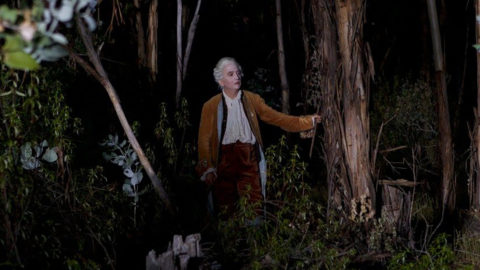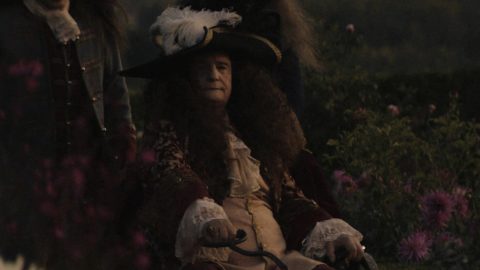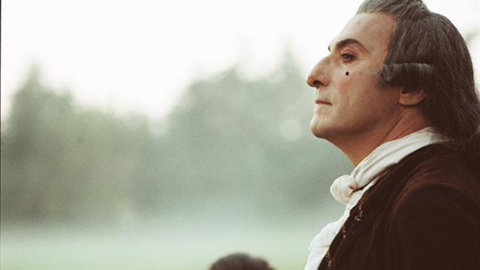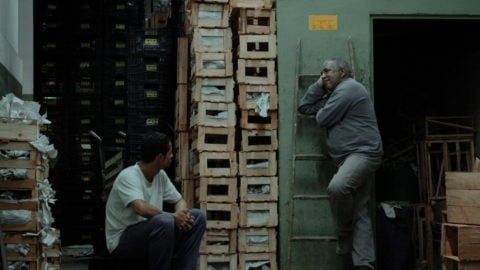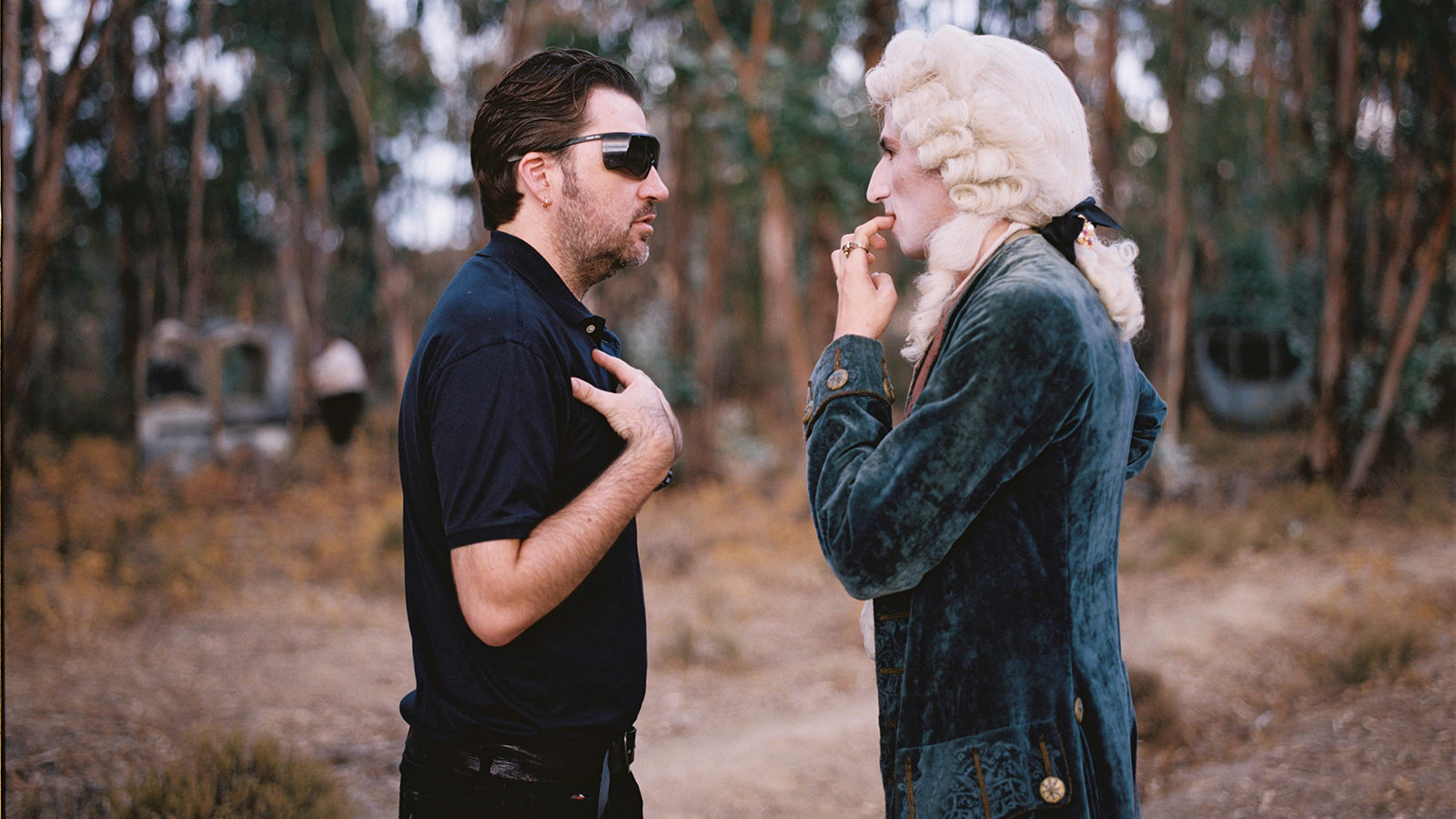
Devil’s Playground: Albert Serra
Winner of the Special Jury Prize in Cannes’s Un Certain Regard sidebar, Albert Serra’s radical exploration of sexual pleasures Liberté will be released this year by Cinema Guild. I spoke with Serra at his company Andergraun Films’ headquarters in Barcelona.
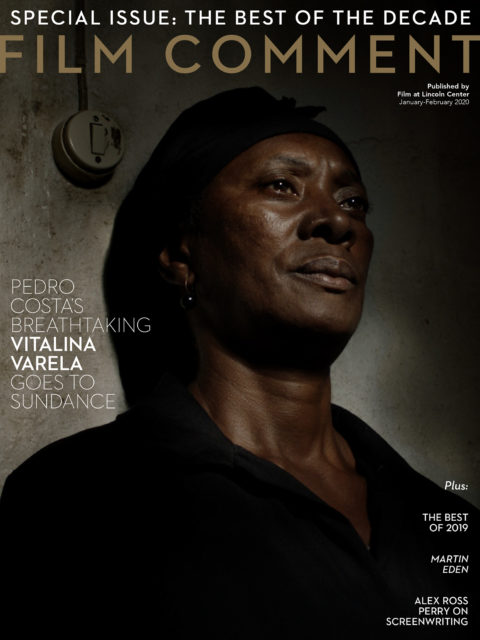
This is an expanded version of an interview that appears in our January-February 2020 issue. Liberté will be available to stream May 1 on Film at Lincoln Center’s Virtual Cinema.
In historical terms, Liberté could be seen as a follow-up to The Death of Louis XIV, but I’m most interested in their differences. The Death… deals essentially with the notion of the ego, that of the Sun King, a man fully aware of his “greatness” and a character which occupies the center of the movie, both thematically and physically. On the contrary, Liberté confronts the notions of ego, narcissism and centrality. Here the characters have almost no psychological depth and we see them regularly wandering around the shots in search of diffused objects of desire. Was doing Liberté a way to free yourself from any traditional form of narrative and mise-en-scène?
It’s an interesting observation. I see what you mean, though I’m not sure if I was aware of this contrast while making Liberté. The movies I make respond essentially to the logic of my life. I may be influenced by the work of a given artist and I try to be true to certain artistic principles, but the force that guides/drives my work is always linked to circumstances: how to go on, where to do it, with who… For Liberté it all took shape when, at the 2018 Berlin Film Festival, some producers suggested me to make a film based on the stage play, also called Libertè, I had directed for the Volksbühne theatre.
Regarding your question about the ego, you’re right in that The Death of Louis XIV had narcissism as a central theme but Jean-Pierre Léaud was not egocentric at all in his way of working. Where I suffered a lot was during the production of the stage play. I worked with professional actors from the Volksbühne company, which are very talented people who have substantial mastery in the technical aspects of acting. There you could feel very tangibly the sovereignty of the actors. During the rehearsals I tried to establish certain stylistic foundations, mainly minimalistic principles, but the day of the performance they ended up doing whatever they wanted, acting expansively, looking for the audience admiration and applause. So I guess I became quite fed up with those actor’s egos. So for Liberté, the film, maybe as a reaction to the stage experience, I took to the extreme the aspects of my method that take all power from the actors: working with three cameras rolling perpetually, with minimum communication with the actors, and with the editing as a weapon which can completely destroy what was built during the shooting. I shoot with three cameras and using zoom. I’ve never used fixed lenses, which is what use the 90-95% of directors. The work with a fixed lens requires a rigid way to operate, having to prepare each shot with precision. My three camera operators work independently and they’re free to approach the action however they want by zooming in. That creates an immense sense of uncertainty and confusion on the actors, which in Liberté, on top of that, had to face the issue of nudity.
In relation to the destruction of the ego, Liberté explores certain forms of sexual pleasure that imply an abandonment of the self. This pleasurable objectification of the self in the hands of the other is very present in the writings of Catherine Millet, mainly in The Sexual Life of Catherine M., which you’ve mentioned as an influence for the conception of Liberté.
Yes, she describes an abandonment of one’s own body for the sake of pleasure, but also an abandonment of any sort of morality. What’s interesting is to consider the price you pay for this abandonment, for the indulgence in what George Bataille called a “useless waste” of energy, alien to any form of social or natural profit. In Liberté, a character says: “This is the price we pay for changing the world”. Libertines, with their extreme sexual practices, have been pushed to clandestine life, exiled from the puritan court of Louis XVI. But that’s just a political price to pay. I’m more interested in what could be considered an existential and aesthetic sacrifice. Once you renounce to your own subjectivity, your individuality, what you desire, what you think you deserve—and I’m talking here about my characters but also about my method of filmmaking—, then the price to pay is a certain dehumanization. That’s what you perceive when you read the Marquis de Sade. There’s something mechanical in his description of sexual exploits, as happens too with Catherine Millet’s writings. If you decide to follow this subversive sexual utopia—where the crowding of the bodies destroys the capitalist laws of supply and demand—you end up losing part of your humanity. In this sense, Liberté evokes a certain despair: something dark, merciless, cold, clinical.
Connected to this notion of dehumanization through mechanical action, I’ve always been interested in the fact that a film camera operates clinically. The camera never gets tired, it doesn’t think, doesn’t listen, doesn’t see beyond the frame. The eyes and the mind of the director are the ones that provide filmmaking with a human touch. This is why I never look through the camera viewfinder or at the monitor while we’re shooting—to keep a human perspective not corrupted by the machinal perspective of the camera. With its merciless, tireless vision, the camera reveals things that the human eye doesn’t see. This is why I love shooting very long scenes. Sometimes we shoot for 30 minutes or even for one hour with no cuts, never stopping. There’re few filmmakers that trust so much in the mechanical nature of the camera. You have a documentarian like Wang Bing who shoots very long scenes, but he doesn’t have to deal with a fictional setting and with actors, except in his few fiction features.
I also see these ideas of abandonment and merciless vision somehow connected to the unceasing questioning of the self which has propelled the evolution of Western culture. Think of European art from Romanticism to our days. We see one avant-garde movement after another, each destroying what was built by the previous one. A pure, perennial anti-canonical battle that is mostly founded on the notion of moral ambiguity. This is what I see in the Marquis de Sade. In broad terms, you could say that, before the Eighteenth century, sexual desire was only conceived as a form of reproduction and pleasure, but nobody thought that sexuality could be an integral part of human identity, an essential element of our intimacy. This fully emerges with Freud, who talks about the perversion inherent to the simple act of looking at your own sexuality. This is all at the heart of Liberté.
Is this foundational linkage between sexuality and identity what took you again to the historical past, as has happened with all your previous feature films?
Here I have to refer again to the circumstances. When I was asked to do the play for the Volksbühne, I proposed four ideas and three of them were set in contemporary times, but they opt for the historical one. So I wrote the play trying to evoke the literature of the Marquis de Sade, with very repetitive, circular and machinal dialogues, but I knew I wanted to subvert the preconceptions associated to a period stage play. The stage design was very beautiful and detailed, very Rococo, but the action was trashy and the lighting scarce. The Volksbühne is a giant theatre, conceived to host monumental plays where the German actors recite great speeches, but my characters were whispering all the time. A critic wrote a negative review of the play, describing it as “two hours of actors abandoned on the stage”. I thought it was great, that was just what I was looking for.
Between the stage play and the film, you produced a two-screen installation for the Reina Sofia Museum in Madrid using material from Liberté’s shooting. Which were the main differences between the installation, called Personalien, and the film?
For the installation I didn’t use dialogues so I had to focus on creating atmospheres. Moreover, as the space for the installation was quite large, and the two screens were very separated, I decided to play with the impossibility for the viewer to watch both screens at the same time. This created a feeling of defenselessness in the viewer, reinforced by a very chaotic soundscape.
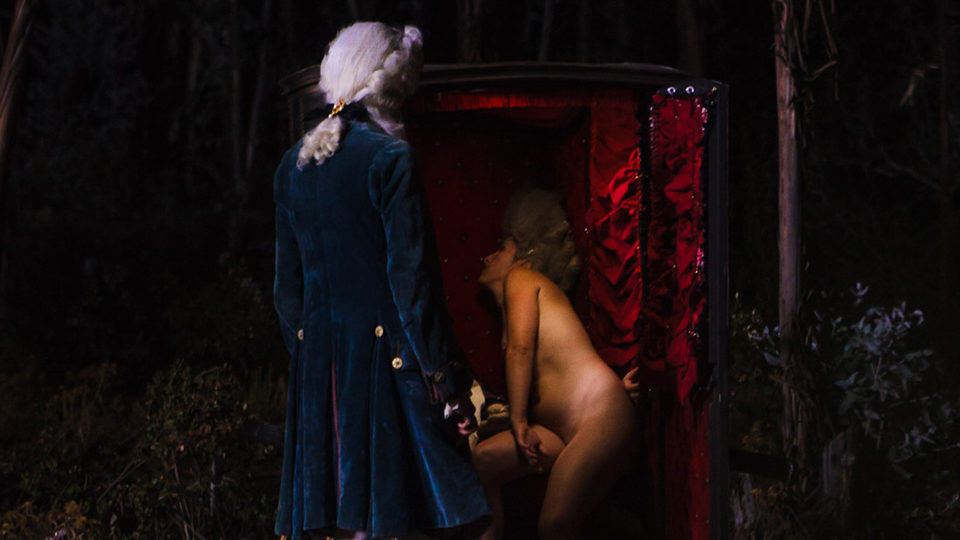
Liberté (Albert Serra, 2019)
To finish with the discussion around the destruction of the notion of centrality, I’d like to ask you about the mise-en-scène and the framing in Liberté. I feel that most of the shots are “centripetal”, as described byAndré Bazin. The actors are constantly looking at something which is off-camera and the soundscape is very rich. This heightens the viewer’s desire to see more, reinforcing his condition of voyeur.
In the movie I destroy all forms of centrality. You never quite know who’s looking at who, where’s happening what. There’s not a clear, singular point of view. I tried to create an effect of circularity through the gazes of characters towards the off-screen space and through sounds coming from beyond the frame. The sensory and imaginary worlds collide in the space off-camera. And then, there are four or five shots very consciously distributed along the film that are practically emptied out of any human figure. Some of those shots are coupled with shocking sounds: people moaning or howling in their sexual intercourses. But there are a couple or three of these shots that have almost no sound at all. Faced with those “empty” shots, the viewer can fill the image with his own fantasies and demons, or maybe speculate with the possibility that the libertines have momentarily abandoned their practices just to spy on the audience.
I also must point out that in my wish to destroy any centrality, I’ve worked a lot with synthesis images, generated by the superimposition of different shots of the woods. In post-production, any time I found an image too easy to read, too simple, I decided to combine different images to create a more chaotic one, with more branches. I’d say that the 30% of the shots of Liberté have been modified digitally.
Liberté plays with the dichotomy of intimacy and exhibitionism. Paradoxically, the closer you get to the character’s intimacy, their acts seem more ritualized, more
codified by sexual practices related to sadomasochism or perversion. I wonder if in Liberté there’s any room for the spontaneity and innocence which was essential in your first films, mostly in Honour of the Knights (Quixotic) and Birdsong.
I still see innocence in Liberté. In my first films, the spontaneity flourished from our belief in a ludic, playful way of filmmaking. Now I’m much more interested in finding a certain truth by putting the actors in an uneasy situation: the three cameras, the lack of communication with them, the absence of a script, the nudity. This methodology leaves the actor without any control of his own image and I think that it’s there where innocence and truth emerges. It would’ve been different if I had decided to use porn actors, because they have an extreme control over their own body, but I wasn’t interested in that. I prefer the vulnerability of the non-actor.
But the cast of Liberté is very heterogeneous, isn’t it?
Yes, there are some professional actors, but also friends from Banyoles (Serra’s birthplace, in the northeastern Catalonia), people we cast through Facebook, theater actors who had never worked on a movie, and also people from the crew, who were the ones who ended up doing the most extreme scenes. The girl in the hardest S&M whipping scene was a set decorator, and the guy who appears nude and bewildered between three or four libertines was a member of the production team. The diversity of the cast was very useful to me, because having very different backgrounds the actors couldn’t easily create an affinity, a team spirit. Besides, the shooting was short, only three weeks, so when the actors were starting to know each other, to create bonds, and when they could potentially take the control of the film, it was the end.
Regarding the notions of vulnerability and fallibility, one of the funniest moments of Liberté is the scene in which one of the libertines is unable to satisfy one of the damsels, and she gets really angry and cruel with him.
Yes, we show some “technical” failures from the libertines but not moral failures. They try and try again to satisfy their desires and give light to their libertine utopia. I appreciate their determination.
Your movies are full of marginal utopias, from the ideals of chivalry in Honour of the Knights to the libertine life of Liberté, but there’s a palpable difference between the joyfulness of your Don Quixote and Sancho Panza and the secrecy of your libertines.
That’s the story of my cinema. It was originally conceived as a “natural” utopia, where we dreamed of recreating the life of the Quixote and his belief in chivalry—the most elevated, pure and failed utopia of all—with the most rudimentary tools of digital cinema. As the Quixote invested himself as a knight with his cheap armor, we invested ourselves as filmmakers with a basic digital camera, a cheap computer, a crew made of friends, hard-drives that didn’t work… It was an impossible project that gave birth to something as wonderful as the memorable friendship between Lluís Carbo and Lluís Serrat, the actors that played the Quixote and Sancho Panza. That friendship was born in the fiction but became very real and you can track it from Honour of the Knights to Birdsong—where they played two of the three Wise Men—and then to The Lord Worked Wonders in Me—a metadocumentary in which we visited the actual settings of Quixote’s life—and the installation Singularity, where they played a gay couple who ended up getting married and adopting a child. There’s a great scene in Singularity where they discuss whether to send the kid to Oxford or Cambridge.
But then Lluís Carbo, our Quixote, died in 2016. What could we do? The show must go on. But how? The only option was to “force” the utopia. We were losing collaborators along the way: some were getting married, others were having kids, others wanted to make industrial films, absurd movies… Fassbinder talked a lot about how the tension between personal life and the collective, artistic utopias tend to create strong interpersonal frictions. Under these circumstances I’ve had to “force” my filmmaking utopia and maybe Liberté is a dark reflection of this. What I show in Liberté is clearly a somewhat “forced” utopia. The libertine life is presented as an uncompromising, intransigent project. The libertines even kill a character that shows a shadow of doubt in his commitment to the cause.
It interesting to read your films as the result of a very personal evolution, but with Liberté it’s also very clear that you’re responding to a contemporary climate of oppression, driven by political correction.
Yes, definitely. In this sense, Liberté has several things to say. On the one hand, the movie presents sexual desire as a democratic force. In the sensual and sexual intercourses that take place in the film’s cruising area, social roles vanish in the hands of pleasure: the dominator can easily turn into submission, the master becomes the servant and vice versa. It doesn’t matter if you’re rich or poor, handsome or ugly, young or old, man or woman… The sexual game is played with a blatant arbitrariness. And from that democratic drive emerges the fusion or ambivalence between pleasure and pain, which was something much more common in the cinema of the 1970s. I consider psychological and moral ambivalence as one of the greatest conquests of Western civilization. Think of the Marquis de Sade, or the amount of great art created around the notions of injustice or abjection. In recent the last years, I’ve been increasingly obsessed with the certainty that it’s only through fiction that true empathy can emerge. The only actual way by which I can access your mind, your thoughts, is through fantasy. In this interview we’re just exchanging some rational thoughts that move around the surface of our minds. But through hypothesis and elucubrations fiction allows me to try to conquer your imagination and make visible what’s in your mind. I may fail to get in there, but it’s free to fail—it’s just fiction.
As anyone in his senses, I’m in favor of a political agenda that could improve the lives of the underprivileged and the minorities, and that could establish a real gender equality, but it’s sad that political correctness can diminish the power of fiction. Because, in fact, psychological and moral ambivalence is essential to understand the contradictions and hypocrisies of our time, so very present in the tensions between private and public life. I’m thinking for example about all those left-wing politicians who have a private life structured around by very conservative, materialistic values. But to deny this real contradictions, and even more so, to try to remove these ambivalences from the realm of fiction is a great defeat.
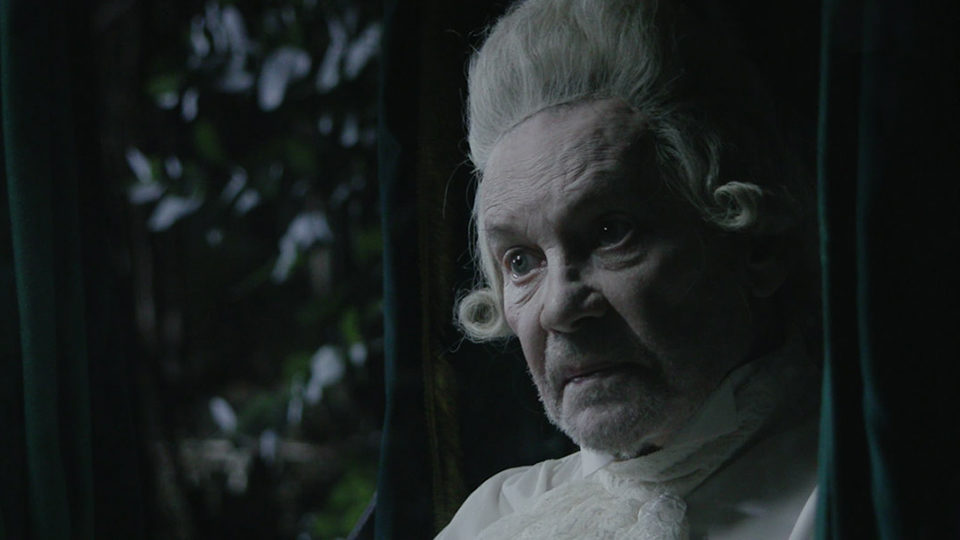
Liberté (Albert Serra, 2019)
I love the collection of blasphemous sentences of Liberté. “Her body will be the sanctuary of our world”, says an aroused libertine. Or “I think they’re praying”, whisper two damsels that are listening to a couple of libertines plotting a perverse sexual game. Or “God is a perverse figure I would love to do business with”. How do these dialogues come up? Are they written or improvised?
For Story of My Death we started creating dialogues which are at the same time quotidian and visionary. They tend to play a poetic role, hardly connected to any narrative thread. I love when one of the libertines of Liberté says: “She’s the greatest performer of them all, she will teach you how to be agent and patient at the same time”. In this sense, I’m very worried by the fact that people doesn’t seem to listen to dialogue any more. TV series have established an audiovisual model where there’s no room for poetic dialogue. All images have a clear centrality and the sound has no other function than to clarify or underline that centrality, which is where lies the most clear, elemental and boring meaning of the image.
I’d like to ask you about a trace of structure I see in Liberté, from a beginning dominated by characters that look at each other and to off-camera—pure voyeurism—to a second half where the libertines seem to free from their clandestine condition and go deep into their sexual fantasies, fearlessly. I’m not sure if this evolution is real or if it’s the result of my progressive immersion in the film.
To talk about structure I have to talk about my process of editing. I start watching all the rushes, in this case 300 hours, and I make a list of all the images that I like for one reason or another: a dialogue, a light, a character’s shoe, a physical gesture… And then me and my two editors, Artur Tort and Ariadna Ribas, divide up the movie in different scenes and start editing. I tend to take the ones with more dialogue. There are no preconceived ideas, just some intuitions, and then we apply what I would call a scientific process in which we link together all those intuitions, all those interesting things I listed, keeping a spatial raccord and a coherence in the dialogues and in the physical interaction between characters. And given that there are not many different possible results to this scientific process, the structure takes shape by itself. For Liberté, we shot between 120 and 130 scenes and the final cut has around 40 or 50, although there are several shots that aren’t linked to any specific scene. This means that we put a lot of effort in editing scenes that don’t end up in the movie. This effort and the sacrifice of cutting out scenes create the structure.
We haven’t talked yet about the night of Liberté, which seems to represent more a state of mind or an amoral sphere than a concrete time framework.
Liberté is a poem about the night. A night that evokes a logic of unproductiveness, or uselessness. Our never-ending night lacks any form of evolution or memory. It’s like a long series of nights where every time, in each new scene, you have to start from scratch. During the day we tend to gather knowledge and process it, but during the night we seem to lose control of this rational skill.
And how did you created this night technically? It doesn’t feel like a day-by-night but neither one of those ethereal nights captured by new high-definition digital cameras.
Our priority when lighting a set is to allow mobility during the shooting. For this we used a helium night balloon that created a sort of silver light in the whole area of the woods where we shot. And then we put lights inside the sedan chairs of the libertines. In the beginning I was a bit afraid that those lights inside the chairs could seem too artificial, especially when a character stood up in a chair and the light reflected on him. But in the last segment of the movie, especially after the storm scene, I decided to enhance the artificiality of the lighting in postproduction, adding more brightness and at the same time lowering the saturation. I wanted to evoke a more contemporary texture, something less sober. In the beginning the look is more Fragonard but the end is more trashy, more artificial, not to the level of Fellini’s The Ship Sails On or Almodóvar, but definitely modern. It’s all very subtle but noticeable.
And how did you came up with the idea of the cruising area and the sedan chairs?
I was thinking about a location were the decadent libertines could operate and then I thought about the tragic and trashy memory of the place were Pasolini was killed, in Ostia, in a waste ground near a beach. I also thought of the small woods you see in the most marginal suburbs of Barcelona. We shot the film in Alentejo, a region of south central and southern Portugal. We wanted to shoot in the Provence-Côte d’Azur in France, but in September it’s already quite cold during the night there, so we decided to move the shooting to the warmest Portuguese region. And I was lucky to find there a wonderful wood of eucalyptus, very brushy, very baroque. The eucalyptus didn’t arrive to Europe until de Nineteenth century. I also loved that anachronism.
And the sedan chairs were an idea I had for the stage play. Helmut Berger was inside one of those chairs the whole play. It was interesting because this evoked a cinematic quality. People from the theatre seats could only see Helmut through the chair’s window. In a way, these old, worn-out sedan chairs evoke the origins of cinema, a simple source of light in the dark.
Ingrid Caven is in the film’s acknowledgements.
Ingrid played an important role in the stage play and we invited her to play a part in the movie, and she was great in her scenes. But being 80 years old she wasn’t comfortable shooting during the nights, something very understandable. We started shooting every day at around 7pm and we went on until 4 or 5am. She did some scenes in the evening but not in the night. Then, in the editing, we realized that the movie had to be essentially a nocturnal experience. So we had to cut her out from the movie. It’s sad because her presence would’ve enriched the portrait of femininity in the movie, but we had to keep the nocturnal coherence.



